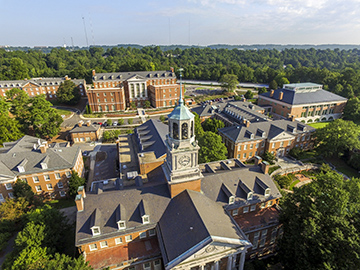
Samford University’s 175-year history is one of academic excellence and leadership. The vision of the institution’s founders to provide a college of high character is as strong today as it was in the beginning. That vision is taking new root in the first major update of the university master plan since the campus moved to its current location in the 1950s.
The university engaged Birmingham-based Davis Architects and Boston-based Dober Lidskey Mathey to assist with developing the new long-range plan, which was approved in concept Dec. 6 by the university’s board of trustees.
The plan features four phases that align with the university’s strategic plan and addresses needs in a long-term, fiscally appropriate and responsible way, according to Harry B. Brock III, Samford’s executive vice president and vice president for business and financial affairs. Brock led a multifaceted, campus-wide review process that resulted in the new plan.
The university sought input from all areas of Samford’s constituency—students, employees, alumni, community leaders and other friends of the university. More than 1,000 individuals participated in different meetings and public forums to formulate and discuss the plan.
Brock said the planning included goals that would enhance the teaching and learning environment, contribute to student success, allow for growth of new and existing programs, improve campus connectivity and space utilization, and address current and ongoing maintenance while preserving the university’s nationally recognized aesthetic.
The plan provides support for continued growth. Samford’s enrollment has grown 22 percent over the last 10 years. University officials anticipate strong growth in undergraduate and graduate programs, including current and new offerings in health sciences.
New facilities for the College of Health Sciences and Brock School of Business provided what Brock called an “incredible opportunity to reimagine space assignment” of spaces vacated by those programs in existing buildings.
Brock said that with “few key exceptions,” Samford has sufficient space available on campus for reutilization to meet growth.
The plan’s four phases extend over a 10–20-year implementation period.
Phase one includes new residence facilities to accommodate expected growth and renovations to existing academic spaces for Howard College of Arts and Sciences and the School of the Arts. Centralized relocation of admission, an enhanced Student Success Center and other student services also are included.
Phase two includes enhanced teaching and learning spaces, renovations to the university center and other academic spaces, as well as additional parking.
Phase three includes potential expansion of College of Health Sciences facilities, and additional residential space and parking to accommodate expected enrollment growth.
Phase four and independent projects might include renovations to student recreation and fitness facilities, athletics facilities, the fine arts center, and additional housing and parking.
Improvements in pedestrian walkways, transportation circulation, sustainability, ADA enhancements, way-finding and signage improvements, and landscaping and contemplative spaces are also part of the long range plan.
Some projects already are underway, including a renovation of the Reid Chapel/Burns Hall/Chapman Hall complex and expansion of the chiller plant as part of the campus infrastructure improvement plan. Components of the transportation plan were implemented in fall 2016. Brock said the plan and recommendations for individual projects would continue moving forward as projects are scheduled and funds are available.
The university recently launched a multiyear, $300 million campaign, Forever Samford, to assist in providing funds for the campus master plan implementation.
